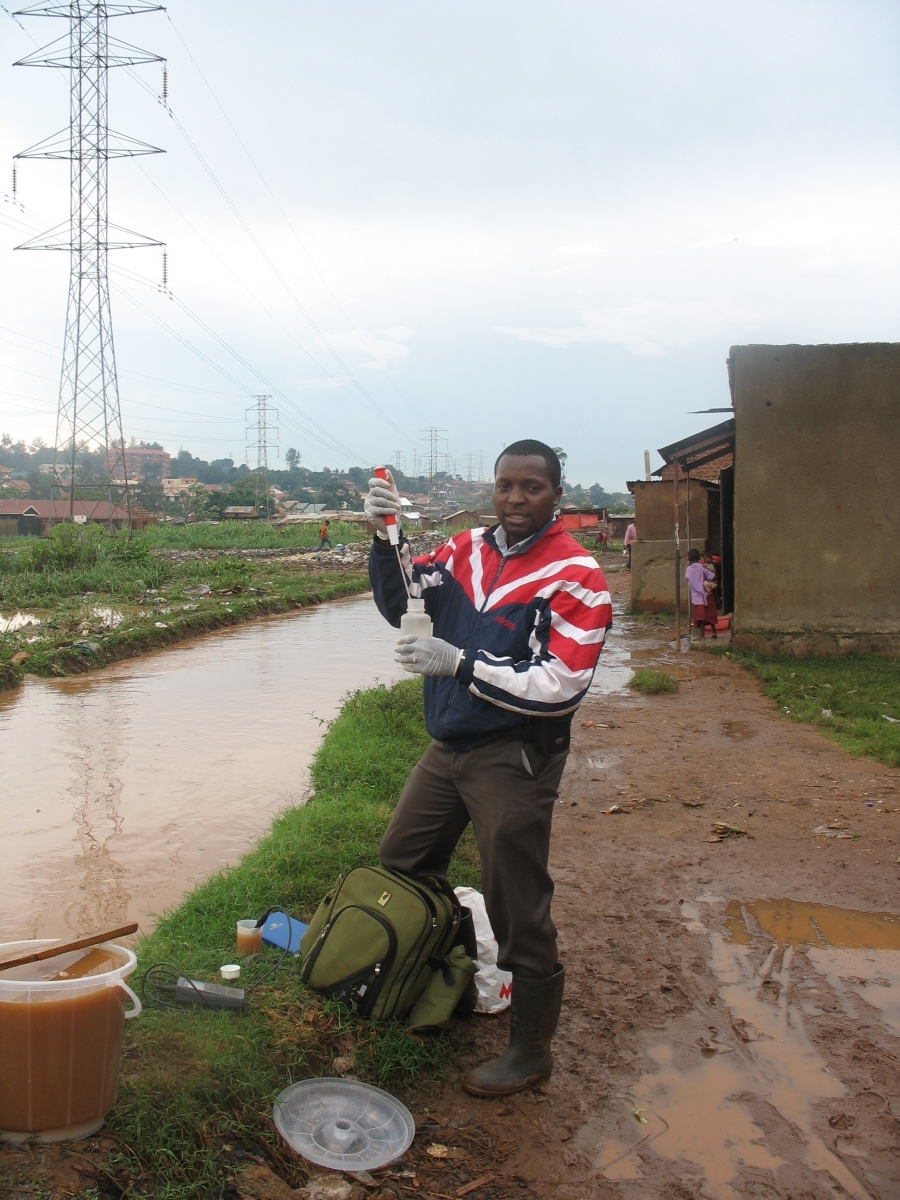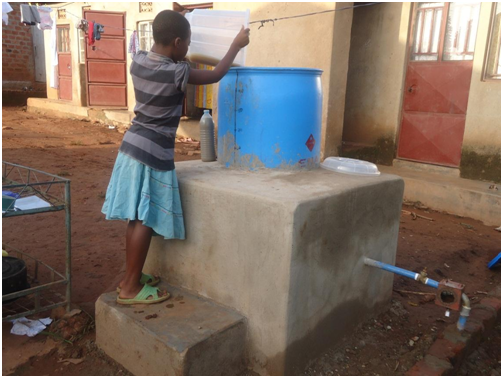Summary of Main Project Results
The SCUSA project has yielded many results, which have been reported on in a series of scientific articles, MSc reports, PhD theses, professional publications, a video documentary, and more (see http://scusa.un-ihe.org/project-output). Here, we briefly report on our most important findings.
Grey water
At least 50% of the surface water in Bwaise was grey water, originating from the kitchen, from washing clothes or from the bathroom with very high nitrogen and phosphorus loads. Only a fraction of these concentrations are required to cause eutrophication. We estimated the grey-water volume discharging the slum to be around 200-300 mm annually, which was in the same range as the annual precipitation excess (precipitation minus evapotranspiration) of around 300 mm.

PhD student Philip Nyenje at work: measuring the discharge in Nsooba drain with the salt dilution method
Realizing the importance of grey water, we decided to construct a grey water filter with the main aim to reduce pollution. Thereto, various set-ups using locally available and cheap filter materials were tested in the laboratory of Makerere University. Then, a two-step crushed lava rock filter unit was designed and implemented for use by a household in the Bwaise III slum in Kampala. We found that removal efficiencies of COD, TP and TKN were 91%, 60% and 69%, respectively. The log removals of E. coli, Salmonella spp. and total coliforms were 3.9, 3.5 and 3.9, respectively. These results indicated that the use of the 2 step filter was a success, and functioned more or less according to what it was designed for originally in the laboratory.

PhD student Alex Katukiza working on the two-step pilot grey water filter installed in Bwaise III slum

Feacal sludge
The majority of sanitation facilities in the slum are the so-called raised pit latrines. They are raised, since the largest part of the pit below the superstructure is above the ground surface in order to avoid contact with the very shallow groundwater (10-50 cm below the surface). We assessed the effect of faecal sludge in the cesspits, both below and above the ground. Underground, in the shallow aquifer, we found significant pollution to groundwater originating from pit latrines. However, we estimated that approximately 2-20% of total N and less than 1% of total P mass input was lost to groundwater from the pit latrines. Our results indicated that in Bwaise III, pit latrines were very effective for the removal of nutrients. In a next step, throughout Bwaise III slum, we installed groundwater observation wells to study groundwater flow and groundwater quality.
Groundwater appeared to be highly mineralized with high EC values, high Cl concentrations, and high alkalinity concentrations. Furthermore, ammonium (NH4) was the dominant N-species, while, to our surprise, o-PO4 was generally absent. The plume of contaminants originated from wastewater leachates fro pit latrines. We observed distinct redox zones in the direction of ground water flow, which changed from nitrate -reducing upstream of Bwaise III to strongly Fe-reducing downstream of Bwaise III. On the one hand, these redox changes were attributed to both the high residence times of groundwater of around 20 year, while on the other hand, the continuous degradation of mobile organic matter originating from the cesspools was held responsible for the strongly reducing conditions in the shallow aquifer. Our findings suggested that lateritic alluvial sand aquifers were an effective sink of sanitation-related nutrients due to strong Fe-reducing conditions that favored N removal by denitrification and PO4 removal by chemical precipitation.

Sampling a groundwater observation well in the field
Above ground, we looked at how cesspits were emptied. We found that individual private cesspool operators or the Kampala City Council Authority (KCCA) were either too expensive for slum dwellers or simply could not access the slum. We established the presence of a vivid manual emptying industry, which provided services for less than half of the price of the cesspool emptying trucks. These manual emptiers dispose of the faecal sludge originating from cesspits into a nearby drainage channel, a pit, which is dug besides the cesspit to be emptied, or simply on 'open ground'. Of course, each disposal method has its price. Because of the poor disposal practices, manual emptying services are considered illegal. So, while emptying, they were always on the look-out for health inspectors and or local council leaders to avoid being arrested for improper sludge disposal. This kind of working environment did not give them room to deliver their services effectively.

Typical manual cesspit emptying
Realizing that most of the surface waters in the area are diluted grey water mixed with some faecal sludge, we determined the pathogenic viral load in various surface waters, groundwaters, and springs used for drinking water. Our results indicated that various pathogenic viruses (rotavirus, adenovirus, hepatitis-A) were present in the slum environment, and that their concentrations were rather high. With these data, a quantitative microbial risk assessment (QMRA) was carried out as an alternative approach for prioritising sanitation interventions. We found that the total disease burden was 9,549 disability-adjusted life years (DALYs) per year. The highest disease burden was 5,043 DALYs per year from exposure to bacteria and viruses in open drainage channels, which was 53% of the total disease burden. Please note that our results showed that the disease burden from all exposure routes was much higher than the WHO tolerable risk of 0.000001 DALYs per person per year.

Microbial risks for children collecting water in Bwaise III slum
In the slum, faecal sludge has no added value. Not for slum dwellers, not for manual emptiers, and not for truck emptiers. However, we are convinced that a change in this attitude is part of the solution. That is, in relation to achieving a reduction of nutrients discharging the slum, but likely also in relation to achieving a healthier slum environment. In recent work, we showed that the conversion of organic waste, or faecal sludge, via the process of hydrothermal carbonization (HTC), also known as wet coalification, led to a black carbon type of product, which, when added to simple sand columns, was able to remove large quantities of cadmium, a toxic metal ion. Also, HTC was able to drastically reduce Escherichia coli concentrations in water, which was passed through columns composed of HTC mixed with sand in set-ups in the laboratory. Although more research has to be done, perhaps HTC is a good example of adding value to faecal sludge. Another example is that in related work carried out in the FaME project, one of the project members found that the caloric value of faecal sludge harvested from cesspits in slums was higher than of coffee husks used to fuel ovens for the tile baking industry. In a follow-up experiment, and to demonstrate the value of faecal sludge, a so-called kiln or oven was constructed, and dried faecal sludge was used for the production of tiles. This is another example of the conversion of faecal sludge into a valuable commodity, which is able to make one or more locally popular industrial processes more efficient and/or cheaper.

A pilot kiln built at Bugolobi Wastewater Treatment Plant to demonstrate the use of FS in the production of tiles (photo: Dr. Charles Niwagaba)
RECOMMENDATIONS FOR INTERVENTIONS
Based on our research, we think that in the case of Bwaise III slum, there are a number of ways forward, which aim to reduce pollution downstream in the catchment in a cheap and sustainable way. These are:
- To actively treat grey water originating from households. Thereto, we designed a follow up of our SCUSA research project, which aims to arrive at an applicable and applied grey water management strategy, which can and will be implemented in slums in Kampala, in Uganda, and, subsequently, in a number of slums in Sub-Saharan Africa. More concrete, we selected a slum in Kampala, and are going to install 20 grey water filter units, similar to the one tested in the field, as described above.
- The manual emptying organizations are key in preventing pollution of faecal matter in drains, especially since they are the ones emptying cesspits, by disposing of faecal sludge into the drains. Legalizing their work, while at the same time facilitating the connection between manual emptiers and private or public truck emptying services seem important ingredients in pollution prevention. At the same time, we hypothesize that an active channel clean keeping program, carried out by public entities like KCCA, in order to keep the channels free from solid waste, could assist in reducing pollution in drains, originating from faecal matter.
- To convert faecal sludge into a valuable commodity, able to make one or more locally popular industrial processes more efficient and/or cheaper. This will prevent the wasteful disposal of faecal sludge into drains, and can therefore not only make industrial processes cheaper, but it can also prevent pollution of surface waters downstream of the slum in the catchment.